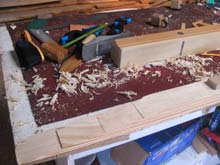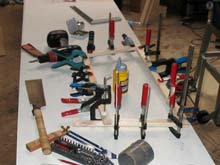Last fall, I built a strongback at the in-laws for another project, but decided against starting then, as we only had a few days left on vacation and I figured it wasn’t long enough to make a good start. So I decided to experiment a bit on a little canoe. Off to the big box store for $25 worth of cheap spruce 9 mm x 12 cm (roughly 3/8” x 5”) wainscotting and a couple of tubes of polyurethane exterior adhesive/caulking.
 |
Impecable, as they say here in France. Family move and an ugly winter postponed the splash for almost 6 months. |
| Cutting the scarfs. |
 |
I cut 10:1 scarfs with my jointer plane, trimmed them up with a jack plane and glued up with some 5-minute epoxy I picked up for a buck a tube at a discount store. For the first strake, starting at the gunwale, I wanted one board, though for the second strake, I just used the tongue and groove ends with some epoxy and very light backing strips and it worked fine. It wasn’t even a problem to keep the grooves lined up.
 |
Gluing up |
I slopped some white paint on the OSB strong back to have a clean surface, to be able to see little things like drill bits, and most important, a place to “loft” out the frames. Eyeball a nice flare and then drew out the frames full size with a straight edge.
I then ripped several boards into strips about an inch wide, using the bevel and the lofted shape on the strong back, and avoiding any big knots, laminated up the frames in place forming sort of ready-made half-lap joints at the corners. Easy as pie. It was warm and the glue I was using, the local version of Tightbond III, was firming up nicely in about 30 minutes so I was able to work quickly.
| Levelling the chines with a Stanley 78 and a bevel stick. |
 |
I screwed two of the frames down square on the strong back spaced by eyeball with the help of a batten, sprang the scarfed-up boards around them, found the bevel of the stem and stern, cut them out with a saw and jack plane and glued and screwed them up. The third frame went in foreward where it wanted to. I cut notches for the chine logs and popped them in and glued up. The second strake I put on by filling the groove with the adhesive caulk and then then pressing it gently down onto the tongues of the boards, making sure I got good squeeze out all along the joint, gluing and screwing at the frames and the ends. Then I got a popsicle stick and made sort of fillets in the decorative bevels between the boards.
Then the bottom, planked out length wise, went on, screwed and glued up with the adhesive caulk, and after a decent interval, I unscrewed and flipped the boat, cut off the tops of the frames and laminated in two new thwarts front and back to take the decks, added spacer blocks in the cockpit and solid strips under the decks and then an inner gunwale or clamp, and an outer gunwale and installed the decks, flipped her over again, sanded quickly and got a coat of paint on the bottom up to the first strake inside and out.
Then a couple of coats of varnish over all, and .... back home with no chance to try her out. bummer.
 |
Canoe paddle |
I also made a double paddle out of the spruce. I drew out the blades 4” wide x 12” long, and the shafts a little over 1” wide and 3’ long, choosing the boards to avoid any bad knots , and then ripped 1” wide boards a little over six feet long out of the spruce. I scarfed the two blade/shaft pieces together (probably overkill, but it just took a minute), measuring so that my two other boards would overlap and reinforce the blades by about 6 inches, and then laminated the three pieces together. A copper rivet at each end of the shaft, some epoxy to seal the endgrain, and three coats of varnish completed the deal. It is surprisingly light and flexible, but the laminations really give it strength, and compared to a couple of other 6-mm ply blades I have broken, the blades are very strong too.
| The scarf inside the three laminations. |
 |
Doing the math, I had about $30 in wood, less than $10 in glue and maybe a couple of bucks in stainless screws, and whatever in some leftover paint and varnish. Time was probably around 20 hours over maybe a week, if you don’t count the cigarette breaks and the sitting down to sip a bit of rose wine and stare out the window at the clouds rolling by over the valley.
I think that eventually the boards will start to split or crack, but t has been about 6 months since I built her, and it hasn’t happened yet. Hopefully it will stay like that, as she is well finished and I store her in a relatively humid cellar. If so, I supposed I will have to decide whether to just ditch her, or cover the hull with glass/epoxy, or more likely, given what that would cost, do a cloth/paint job.
In any case, the cost was probably around that of doing the job in cheap luan plywood, but the spruce was much more pleasant to work with, though much more fiddly. We’ll see how she hangs in there.
***** |

